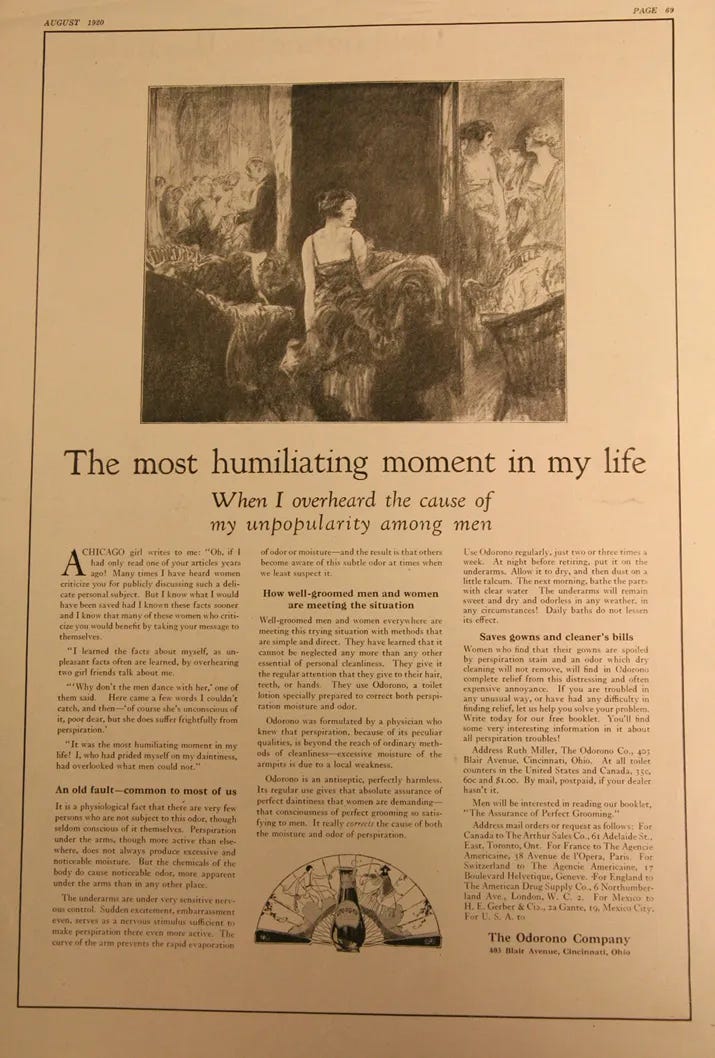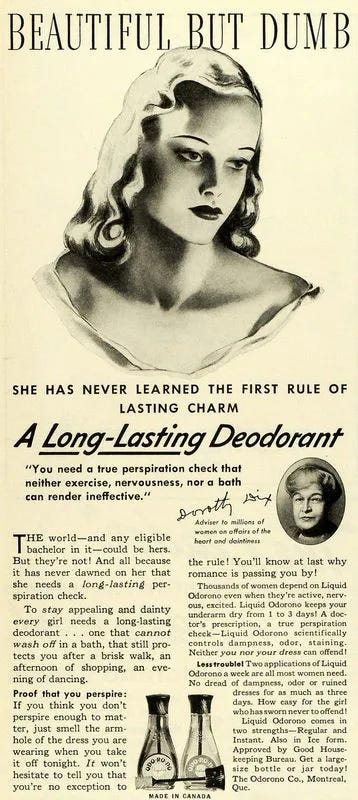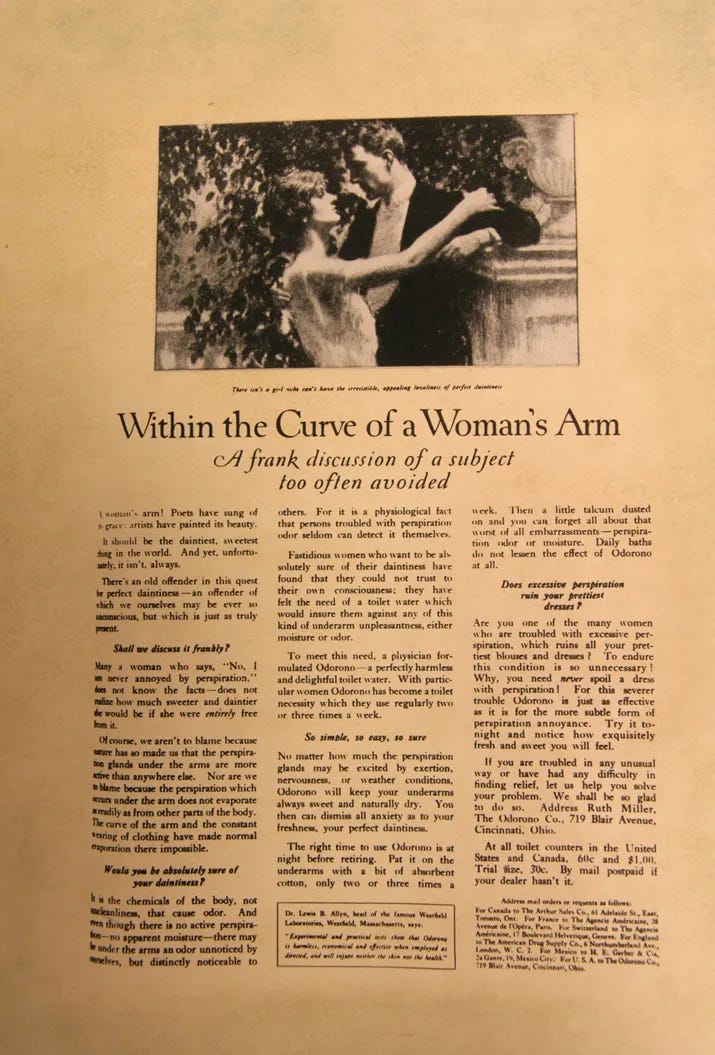Sweat Attracts! How Shrewd Marketers Convinced Americans to Spend Money on Deodorants and Perfumes
Colognes and Deodorants Could Actually Harm Mating and Parenthood Chances
While the aroma of deodorants, colognes, perfumes and fresheners (cars and buildings) may be appealing to many, especially urban folks, it is “appalling” to others among us who are chemically-sensitive. The artificial aroma is also not the best thing for our health or reproductive chances! I used to use these products and then stopped when I realized their direct link to my recurring headaches. But it’s a lot more than headaches that you risk when using artificial aroma generators. Let me explain the science in simple terms, and also share with you the interesting history of how a couple shrewd marketers convinced Americans they smell bad and need expensive harmful chemicals on their body.
We will first start with e science of attracting mates, because that is probably the leading reason many people use artificial scents.
How Does Attraction to Mates Work in Nature?
In the animal kingdom, the animal’s metabolic health (neuroendocrine health of an organism: Neuro means nervous system and endocrine is the hormonal system) is what makes it attractive for mating, reproducing and passing on its traits and life’s “transgenerational coded cellular memory” (called genes). After all, metabolism and hormones are all about energy and vitality. In some species like frogs, louder and more frequent grunts (deeper and stronger voices) signal a healthier metabolism (energy) that attract females to breeding ponds! Apparently female frogs can even count these grunts. Roosters also show their virility with louder and more frequent crows. In other species, like spiders, more colors and nicer “dance” moves signal vitality (energy) and fitness for mating (although it may not bode well for the males, as I explained in my earlier article Cannibalistic Mating: Why Do Some Organisms Eat Their Mating Partner?).
In mammals, however, it’s often the outward smell of the internal hormones that give away the animal’s internal hormonal and metabolic health. For example, it is said that cholera smells sweet and acute diabetes like rotten apples. Mammals (except humans that use biohacks like hormone therapy, supplements, drugs, Botox, etc.) mainly show their “natural” attractiveness and fitness for reproduction through the release of their hormones, sometimes called pheromones. For example, Dog's anal glands release distinct pheromones revealing dog’s health, age, emotions and sex. Even if the dog is scared, the anal release of stress hormones like cortisol can be detected by other dogs. As a result, when dogs are threatened, or sick, they can only cover up their hormonal/metabolic truth by tucking in their tails to block release of anal pheromones! It is the smell of these anal pheromones that prompts dogs to sniff out each others’ rear ends (or even humans’). It gives them a real-time, and honest (natural) indication of the health and hormonal (pheromonal) metabolic balance of other dogs.
The Problem with Covering Up our Natural Odors
Now let’s get to humans. In humans, the axilla (the underarm) is analogous to scent glands in other mammals. There are reports that the odor of a body changes with emotional state. People who were placed in situations that provoked anxiety, e.g., watching fear-inducing film clips, changed their body odor. Unlike dogs, however, humans do not need to cover up their real ends (we do but for other reasons!) to hide their emotional state or hormonal health. Instead, we are masters of disguises. We use elaborate “words” to influence others’ evaluation of us. We use clothing, and all sorts of chemicals and biohacks to look more appealing, including colognes, deodorants and perfumes that are designed to bypass and deceive our natural pheromone detectors. So how do perfume designers achieve this?
Studies have shown that an extract of sweat, collected from pads that were worn in the armpit of male donors, when applied to females’ upper lips shifted their mood and made them “more relaxed” and “less tense.” Aware of this natural phenomenon, top perfume brands for women actually use synthetic analogs of odorous steroid-type male “sweat” pheromones like androstadienone to improve women's mood and focus in the presence of men. That in turn facilitates her mental and sexual arousal. In other words, expensive synthetic perfumes fool women’s brains to sense a healthy masculine men around, because apparently modern men either don’t sweat, or use deodorants/colognes to block/mask their natural sweat pheromones, or have non-masculine sweat pheromones (with low testosterone to estrogen levels, vitality and virility)! Once the woman’s brain is fooled (biohacked) to sense an eligible mating partner around, her mood and focus improve, relaxing her body and balancing her hormones enough to release feminine pheromones like estratetraenol that in return attract men. So as you see, like all other biohacks, our denatured species has invented complex expensive roundabout ways to activate nature!
The problem with “smell” biohacks like perfumes, colognes, fresheners and deodorants, in addition to the cost of these overpriced items, is the interaction of their ingredients with the “natural” hormonal balance and health of both men and women. When absorbed by the skin or through our nose, petroleum-based chemicals and hormones, because they mimic our natural hormones, are believed to act as “endocrine disruptors.” As explained in my books, hormones are “signal” molecules used by the body and brain to communicate with each other. Disrupting these natural hormone signals is linked to all sorts of health problems, especially problems with fertility and sexual potency (for example see my article How Diet and Lifestyle Impact Women's Fertility, Menstrual and Menopause Problems).
Furthermore, by fooling ourselves and potential partners in the mating and attraction game, we only lessen our real (natural) chances of finding a good match attracted to our “real” pheromones and unique neuroendocrine system. The major histocompatibility complex (MHC) genes are important for the immune system, and appear to play a role in sexual attraction via body odor, potentially enhancing the chances of healthy offspring. So a “natural” hormonal match means lasting attraction and bonds. In fact, each person’s sweat provides a “chemical signature” for them. That is why adult humans can identify their own worn T-shirts out of 100 identical shirts worn by others. Family members can also identify T-shirts belonging to their partners, children and siblings. Even breastfed infants can identify the axillary pad belonging to their mother – assessed by the duration of orientation of their heads toward the pad.
The problem with masking or disrupting our natural pheromones is their key role in hypothalamic-pituitary regulation of our entire hormonal system. For example, natural pheromones in women are shown to cause synchronization of several endocrine functions and behaviors (lactation, motherhood, menstrual synchrony, etc.). Disrupting or masking these natural pheromones using synthetic volatiles does not seem wise.
Specific Problems with Deodorants
They often plug skin pores and prevent the natural cooling and detoxification effect of sweating, plus they block the natural pheromone signaling.
The use of Aluminum salts in antiperspirants has been linked with the systemic accumulation of aluminum and an increased risk of Alzheimer's disease.
Estrogenic preservatives like Paraben, used in deodorants, are linked to breast and prostate cancers.
Aluminum Zirconium salts are suspected endocrine disruptors and carcinogens. They are known to cause pulmonary sarcoid-like granulomas similar to those common in cancer patients.
Interestingly, some expensive new “natural” deodorants have stopped using aluminum and synthetic chemicals and instead use alkaline compounds and lactic acid bacteria without realizing the natural human underarm sweat contains alkaline nitrogen-based compounds and lactic acid bacteria. So the natural antiperspirants try to mimic nature’s perspiration wisdom using expensive man-made compounds!
How Shrewd Advertisers Convinced Americans They Smelled Bad
The following is a modified excerpt from an an interesting article published in the Smithsonian Magazine, which shows how a century ago, most Americans rightfully believed blocking perspiration (sweating) was both unhealthy and unnecessary until the daughter of a wealthy doctor and a former traveling Bible salesman, through disinformation campaigns, helped turn deodorants and antiperspirants into an $27 billion industry (in 2021):
In the 1910s deodorants and antiperspirants were relatively new inventions. The first deodorant, which kills odor-producing bacteria, was called Mum and had been trademarked in 1888, while the first antiperspirant, which thwarts both sweat-production and bacterial growth, was called Everdry and launched in 1903. But many people—if they had even heard of the anti-sweat toiletries—thought they were unnecessary, unhealthy or both … Yet 100 years later [in 2012], the deodorant and antiperspirant industry is worth $18 billion. The transformation from niche invention to a blockbuster product was in part kick-started by Edna Murphey, a young woman who used her grandfather’s wealth to heavily market an antiperspirant that her father, a surgeon, had invented to keep his hands sweat-free in the operating room.
Murphey hired a New York advertising agency called J. Walter Thompson Company, who paired her with James Young, a former door-to-door Bible salesman. Young’s early Odorono advertisements focused on trying to combat a commonly [rightfully] held belief that blocking perspiration was unhealthy. He actually tried to equate sweating to an ailment! His ad campaigns pointed out that Odorono (occasionally written Odo-ro-no) had been developed by a doctor and it presented “excessive perspiration” as an embarrassing “medical” ailment in need of a remedy. {This is an early example of a chemical/medical disinformation campaign, turning something unhealthy into an essential cure for a non-existent disease!]
Within a year Odorono sales had jumped to $65,000 and the antiperspirant was being shipped as far as England and Cuba. But then the sales remained flat until an advertisement in a 1919 edition of the Ladies Home Journal with a take-home message that “If you want to keep a man, you’d better not smell.” Although the ad insulted almost every woman in America, the “brain-washing” strategy worked. Odorono sales rose 112 percent to $417,000 in 1920, the following year.
By 1927, Murphey saw her company’s sales reach one million dollars. Then they went after American men who considered a deodorant to be for sissies!
The first deodorant for men was launched in 1935. As with the products for women, advertisers preyed on men’s insecurities: In the Great Depression of the 1930s men were worried about losing their job. Advertisements focused on the embarrassment of being stinky in the office, and how unprofessional grooming could foil your career,
Association with manhood, Sea-Forth, a deodorant sold in ceramic whiskey jugs starting in the 1940s, “because the company owner said he ‘couldn’t think of anything more manly than whiskey.”
Other Unhealthy Trends
As explained in my article Why are Humans Losing Their Sense of Smell? whenever we overload our olfactory with unnatural smells and flavors, we not only activate inflammatory responses in our immune system and sinuses, we also risk losing some of our smell and taste senses. Olfactory impairment is indeed associated with neurobehavioral diseases and mental illnesses such as schizophrenia, depression, Alzheimer’s and Parkinson’s. In animal studies, it has been shown that healthy olfactory nerves can help brain-damaged animals like salamanders, frogs and fish to replace and regenerate large parts of their destroyed brains, while impaired olfactory nerves can prevent recovery from brain damages. I discussed the extreme importance of preserving our “natural” sense of smell by avoiding synthetic “unnatural” aroma and artificial flavors.
A concerning trend in the world is the widespread installation of remote-controlled synthetic scents and “fresheners” in buildings to create “uniformly scented atmospheres and odor remediation using pleasant ambient scents that alleviate anxiety and create a sense of comfort!” These are basically code words for forcing an unsuspecting shopper, visitor, resident or employee in a building to constantly breathe synthetic chemicals without having a choice. I have literally ran out of buildings using the technology given its immediate effect on my nerves and headache. I have seen other unsuspecting people exposed to such unescapable chemical emitters have teary or itchy eyes, or start coughing.
What is Next?
I have spent the last 24 years in trying to find the truth about our health and learn how the biochemicals in our body (hormones) and food balance our body and brain. In 1762, Jean-Jacques Rousseau wrote in the Social Contract: “Truth does not lead to fortune; and the people bestows neither Ambassadorships, professorships, nor pensions.” This is the book that was for the large part responsible for the freedoms we enjoy in America and for drafting the US Constitution.
Finding the truth about how things work, or do not work, is becoming increasingly difficult because most information today is sponsored by businesses. I don’t use highly-paid publicists and have no sponsors. You can help unsponsored folks like me share uncensored truth and discoveries by:
Subscribing to these blogs (preferably paid for less than $5 a month or as a free subscribe if you cannot afford it)
Sharing these articles as widely as possible.
Buy my independently-published books on Amazon (no Big name publishers or influencers were paid to promote them!).
Arrange for me to present these topics in person, for free, near you.
Sources:
https://pmc.ncbi.nlm.nih.gov/articles/PMC3987372/
https://pubmed.ncbi.nlm.nih.gov/9575492/
https://www.smithsonianmag.com/history/how-advertisers-convinced-americans-they-smelled-bad-12552404/
https://journals.sagepub.com/doi/10.2466/pms.1989.69.1.219
https://anatomypubs.onlinelibrary.wiley.com/doi/full/10.1002/ar.a.20125











Women have a much better ability to discern odors than men. They have 50% more neurons dedicated to odor detection and discrimination. https://www.perplexity.ai/search/are-women-able-to-detect-smell-GMz6nwvISvKucp0CNBQ5Xg
This, a history of deodorant of all topics, is a surprisingly excellent investigation of an example of early propaganda.